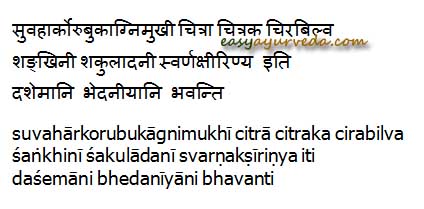Bhedaneeya Gana Of Charaka- Cathartics: Review, Benefits, Formulations
By Dr MS Krishnamurthy MD (Ayu), PhD.
The herbs which pierce deeply and penetrate and hence produce the action in deeper tissues like Mamsa (muscles), Meda (adipose tissues, Asthi (bone tissues), Majja (marrow) and Shukra (reproductive tissues) are referred by the name – Bhedaneeya.
Such drugs are hot in potency, light and deep penetrative or sharp in quality. Most of the spices too have this property. Usually they cause their action within 30 – 45 minutes of the medicine intake. Also their effect will be persisting for 2 – 3 days. Some of the toxic, poisonous and semi poisonous substances do possess this property.
Table of Contents
Bhedaneeya Gana

Classical reference: Charaka sutra 4/9
1. Suvaha/Trivrith (Operculina turpethum B. ) – Roots
This is a good purgative, anti flatulent, anti helmethic and spasmodic contracture.
It is used in treatment of Kapha and Pitta dominant disorders. Apart from being useful as a medicinal herb, it is also a very important herb used in Panchakarma treatment called as Virechana – Purgation treatment.
2. Arka – Calotropis gigantea – Whole plant
Anti helmenthic, carminative, digestive, alkalizer, stimulant and anti spasmoidic.
It is widely used many Ayurvedic treatments, both externally (ksharasutra) and internally. It is a very common herb seen widely throughout India. It is called as Madar in English. Often, its another variety Calotropois procera is also used in the same name.
3. Urubuka – Castor – Ricinus communis – Roots
Cholegogue, anti flatulent, laxative, quick acting, deep penetrative etc.
Castor root, seeds and leaves are extensively used in Ayurvedic treatments, both for externally and internally. Castor is aphrodisiac, relieves pain and useful in neurological disorders.
4. Agnimukhi – Gloriosa superba – Rhizome
Abortificient, digestive, stimulant, anti spasmodic, analgesic etc.
Langaliis a plant mentioned in Ayurveda for the treatment of wound, swelling, skin disease, bite from poisonous animals, difficulty during labor, intestinal worms etc.
5. Chitra/Danti – Baliospermum montanum – Roots and seeds
Anti helmenthic, purgative, anti flatulent etc.
It induces diarrhea and is useful in treating liver disorders, digestive disorders, hemorrhoids etc.
6. Chitraka – Leadword – Plumbago zeylanica – Roots
Digestive, carminative, stimulant, abortificient, poisonous, irritant etc.
7. Chirabilva – Holoptelia integrifolia – Stem bark
Circulation regularizer/provider, penetrative, cathartic etc.
Indian Elmis a herb mentioned in Ayurveda for the treatment of localized swelling, skin diseases, nausea, diabetes, indigestion, piles and acts as blood purifier. It is commonly called Chirabilva in Ayurveda.
8. Shankini – Canscora decussate – Whole plant, Fruits
Purgative, deep penetrative, blood purifier, complexion enhancer etc.
9. Shakuladani – Picrorhiza kurroa –Rhizome
Cholegogue, liver stimulant, appetizer, bitter tonic, anti helmenthic, purgative etc.
10. Svarnaksheerini – Argemone mexicana Linn – Whole plant, Roots, Aqueus extract/resin
Purgative, anti spasmodic, stimulant, liver tonic, cholegogue, menogogue etc.
A source for bio diesel, is used in Ayurveda to treat non healing wounds, constipation, Malaria, chronic fever etc. It is also used in Virechana Panchakarma treatment.
Qualities
Qualities in general and actions of Bhedaniya gana drugs:
Most of the drugs referred above are light(laghu), penetrative(teekshna), dry(ruksha) and hot(ushna) in nature. They are bitter or pungent in quality and hot in potency. They undergo Pungent kind of metabolic change (Katu vipaka). The above drugs are effective bitter tonics, liver stimulants, drastic purgatives and anti helmethic in action.
Therapeutic uses
Therapeutic uses of Bhedaniya gana drugs:
The above said drugs alone or in appropriate combinations useful in the treatment of several ill – health conditions like constipation, hemorrhoids, ascitis, jaundice, anorexia, liver disorders, uterine disorders, chronic digestive disturbances, menstrual irregularities, abdominal worms, diseases of the phlegm like cold – cough – breathlessness etc.
Ayurvedic formulation
Formulations containing Bhedaneey Gan Herbs:
Trivrit lehya, Chirabilvadi kashaya, Avipatti choorna, Krimihara kashaya, Erandamoola kashaya etc are the few formulations containing few of the ingredients from the list of above drugs.
Disadvantages
Disadvantages of Bhedaniya gana drugs:
As most of the above said drugs are deep penetrative, irritant and drastic purgatives one should be well aware while administering the formulations derived out of these drugs. Especially in the childhood disorders, pregnancy and puerperal period, old aged men and women, in bleeding disorders, menorrhagia, diarrhea etc any of these drugs should be avoided or administered with utmost caution.
Simple formulations that can be made from the above drugs and their application in routine practice:
The drugs like Eranda, Chirabilva, Katukarohini etc are less dangerous drugs and hence in smaller dose they can be administered in the finer powder form. Such formulations even though may not of much use to practice regularly; they can be used in constipation, indigestion, food poisoning, chronic gastric disturbances etc.
Formulation development opportunities:
In Vata and kapha dominant conditions they can be modified into medicated oils. Such oils will have the ability to pacify the numbness, heaviness, circulatory defects, swelling, joint pain etc. In smaller amount they can be added along with Triphala choorna, Panchavalkala choorna etc and for Udgharshana, Udvartana etc it can be brought into practice; they may be highly effective in heftiness of the body, numbness etc.
Click to consult Dr MS Krishnamurthy MD (Ayu), PhD.









